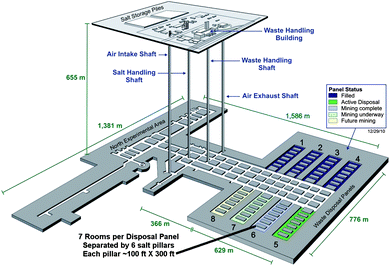Time for another update on the evolving situation at the Waste Isolation Pilot Plant near Carlsbad, New Mexico. Back in February, something happened in this transuranic geological repository in a salt deposit. Plutonium and americium were detected outside of the plant. When it became possible to examine the big underground room where drums of waste from U.S. nuclear weapons production, it was found that a drum had ruptured and allowed its contents to escape. Further research pointed to a set of waste drums that had been sent to WIPP by the Los Alamos National Laboratory. It was surmised that changes in chemical additives to the barrels resulted in generation of either ammonium nitrates or hydrogen gas which exploded, releasing radioactive materials.
On the basis of photographs of the breached drum, a small discolored area of the steel shell of the drum indicates that that area reached a temperature of at least six hundred and forty four degrees Fahrenheit. Examination of the damage to gaskets, plastic backfill bags, shrink wrap and slip sheets in the room suggest that the temperature throughout the room must have risen high enough to melt these materials. Some surfaces of the waste drum reached sixteen hundred degrees Fahrenheit. The waste in a large part of the room must have been heated up to four hundred and forty six degrees Fahrenheit.
Fifty more drums from LANL containing the same nitrate salts as the breached drum may pose a further risk. Temperatures of four hundred and forty six degrees Fahrenheit are sufficient to dry out the nitrate salts in some of these drums. These possible reactions have not been sufficient to show visible evidence but they may result in more breached containers and released radioactive materials. There is a great fear that a chain reaction could occur where exploding drums might trigger even more drums to explode. If sufficient plutonium is released from the drums to pool on the floor and reach a critical mass, a nuclear explosion might occur.
The operators of the WIPP have been asked if there is any plan for them to go in and removed the dangerous waste drums from LANL. Their response is that there is no such plan at this time because of the danger of radiation exposure to any workers who enter the room with the bad drums.
The WIPP is the only permanent geological repository for this type of waste. It is becoming more and more likely that the WIPP will not be opened for business any time in the near future. This leaves dangerous drums of waste in room 7 at WIPP, dangerous drums still at LANL and dangerous drums at a temporary waste disposal depot in Texas which is ill prepared to deal with problems caused by chemical reactions from the drums. Going forward, not only is there the usual danger from drums of radioactive waste but also the danger that the drums may explode and spread radioactive materials into the environment. So far, it does not appear that public officials and WIPP operators have found a way to deal with the situation.
WIPP diagram:
